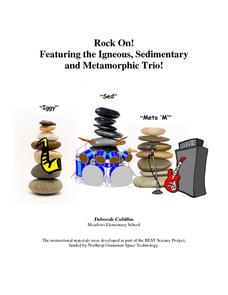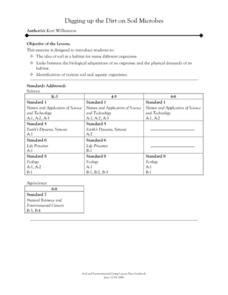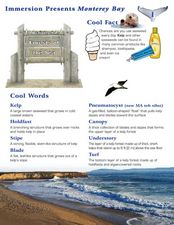King Country
Lesson 4: Relationships - Day 2: Gender Identification
Gender roles and gender identity are the focus of a lesson designed for high school special education classes. Read the introduction to the packet carefully, as it contains advice about how to approach the subject with your...
Curated OER
Plate Tectonics: Fourth Grade Lesson Plans and Activities
The pre-lab portion of the lesson introduces emerging geologists to the various layers that make up Earth. After completing a sheet on the identification of the layers, class members simulate plate boundaries and their...
EngageNY
Solving for Unknown Angles Using Equations
They say a picture is worth a thousand words—and your pupils may agree after this instructional activity! They read a geometric description and create a diagram from that description. Their diagrams help them find unknown measures based...
Curated OER
Botany Basics
Students survey plants. In this plant identification lesson, students explore the difference in plants to aid identification. Students determine which plants may be used for medicinal reasons.
Curated OER
Using Technology For Vocabulary Development, reading Comprehension, and Word Identification
Fourth graders define unknown vocabulary words and decode unknown words in their reading using a Quicktionary Reading Pen and Franklin Spell Checker. They create reading comprehension questions that are incorporated into a classroom Web...
Howard Hughes Medical Institute
Niche Partitioning Activity
Dinnertime on the African savanna is a highly choreographed event! Introduce young ecologists to the concept of niche partitioning through a hands-on activity. Pupils research animal behaviors and use data to develop an understanding of...
Curated OER
Cloze Instruction
Bring Goldilocks and the Three Bears, Mad Libs, and cloze activities to your college class with this instructional activity. They complete a cloze instruction activity in which the students choose words that would fill in the blanks and...
Curated OER
From George to Martha: Writing a Sonnet Using Primary Sources
What was the relationship like between George and Martha Washington? To protect their privacy, Martha Washington destroyed all her husband’s letters after his death so historians have little evidence of their lives together. Two letters...
Curated OER
Letter Recognition Flash Games for Kids
Young scholars explore the alphabet by completing an on-line letter identification activity. For this phonetics lesson, students utilize the website www.literarycenter.net and listen to word sounds as they identify the spelling of the...
Curated OER
Maggie's Adventures Grades 1-2
Learners use Maggie's Learning Adventures online activity. They play a matching or memory game to become aware of homophones. Students recognize that there two ways to use many words. They practice with noun or verb identification by...
Curated OER
Comprehension: Identify the Main Idea from Text
Children in first grade listen and read along with the teacher to practice main idea identification. They use the provided reading passages to read, locate the main idea and supporting details. This is a fully scripted lesson which means...
NY Learns
Culture Clash: Exploring Characters within El Bronx Remembered by ECSDM
Using a character map, learners assign traits to characters from Nicholasa Mohr’s El Bronx Remembered: A Novella and Stories. In addition, groups record evidence from the stories to justify the labels and use these sheets to prepare for...
Curated OER
Schoolyard Jungle: What's Out There?
Eighth graders create a plant study guide using their outdoor classroom environment. In this ecology instructional activity, 8th graders take photographs of plants they collect from the outdoor classroom and create plant field...
Curated OER
Tree Identification
Students are introduced to the characteristics of trees and different techniques to identify them. They distinguish between a deciduous and a coniferous tree. Students describe at least four characteristics used to identify trees. They...
Brooklyn Children’s Museum
Rocks and Minerals in Our Lives
Young geologists discover the important role that rocks and minerals play in our everyday lives through this series of hands-on activities. Starting off with a lesson that defines the difference between plants, animals, and...
Core Knowledge Foundation
Rocks & Minerals
Take young geologists on an exploration of the rock cycle with this six-lesson earth science unit on rocks and minerals. Through a series of discussions, demonstrations, and hands-on investigations your class will learn...
Curated OER
Rock On! Featuring the Igneous, Sedimentary and Metamorphic Trio!
Get your classroom rocking with this four-lesson earth science unit. Through a series of shared reading activities and hands-on investigations, young geologists learn about the three types of rocks and the unique properties of each.
EngageNY
Examples from Life Today
Does that happen in real life? Scholars look at their Themes of Adversity graphic organizers and think of examples in today's world for each type of adversity. They determine if today's world has the same struggles as those in the...
Curated OER
How Big Is A Humpback Whale?
Students explore humpback whales. In this humpback whale lesson, students determine the actual size of humpback whales and use diagrams to identify the major features of the humpback whale.
Curated OER
Digging up the Dirt on Soil Microbes
Young scholars are introduced to the idea of soil as a habitat for many different organisms. They are introduced to the links between the biological adaptations of an organism and the physical demands of its habitat. Pupils are...
Curated OER
Forests of the Sea
Young scholars read about and conduct experiments to learn about the vegetation under Monterey Bay. In this Monterey Bay lesson, students read about and look at brightly colored pictures of the different types of seaweed that grows in...
Maine Content Literacy Project
Introduction to John Updike
Expand your pupils' understanding of the short story genre with a study of John Updike and his story "A&P." This lesson, the fourth in a series of fourteen, invites learners to examine literary terms and read and discuss the story....
New South Wales Department of Education
Plant Features
Pine needles are actually modified leaves. In the 16th installment of 20, young scientists explore plants. Through an analysis of leaves — shape, veins, and edges — pupils see how to classify plants based on structural features.
Curated OER
Chalk and Cheese
Students make comparisons and identify opposites. Through discussion and word identification, students working independently or in pairs, compare and contrast things that are usually thought of as opposites. They practice English...
Other popular searches
- Word Identification
- Basic Word Identification
- Accurate Word Identification
- Word Picture Identification
- Sight Word Identification
- Phonics Word Identification
- Word Identification Practice
- Word Identification Lessons
- Word Identification Skills
- Word Identification Strategies
- Word Identification
- Word Identification Rimes























